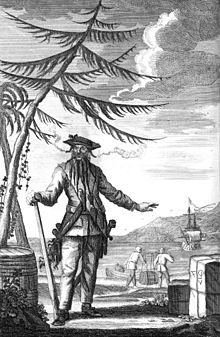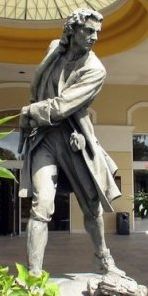Now
that a New Year is under way I thought I’d have a brief re-vamp of my blog.
Nothing drastic, just a few updates, images shifted around etc, and a
Resolution to post an Article of Interest (presented by Moi) every other Tuesday,
alternating with, if I can find a few willing victims, an invited guest with something of interesting to tell.
Well that’s the plan.
It might change...
Well that’s the plan.
It might change...
*
I
was sent a link a short while ago to a newspaper article. It was about pirates –
Blackbeard to be precise – so of course I was interested. In fact, I was sent two links to similar articles, one far more interesting than the other because
it was more accurate. The article was about the ongoing underwater archaeological
search of Blackbeard’s ship, Queen Anne’s
Revenge.
 Blackbeard
is one of the best known of all pirates because we have a full account of his
more outrageous escapades, his somewhat grisly end, and a record of the trial
and hangings at Williamsburg, Virginia, of what remained of his crew. His real
name was Edward Teach or Thatch, and he is believed to have been born around
1680 in or near Bristol, England. The names ‘Thatch’ and ‘Teach,’ are also
noted as ‘Tache’ or ‘Thach’, the discrepancy caused by the frequent
inconsistent spelling of the period. The written word tended to follow the
spoken word, so regional accents played an important part in how spelling was
interpreted. If Edward Teach was born and raised in the West Country he would
have had a broad Somerset accent, which could have resulted in him pronouncing
his name as something like ‘T ... aa ... tch’. He could almost certainly read
and write, for he wrote to and received letters from the Chief Justice and
Secretary of Carolina (with whom he had ‘business dealings’.)
Blackbeard
is one of the best known of all pirates because we have a full account of his
more outrageous escapades, his somewhat grisly end, and a record of the trial
and hangings at Williamsburg, Virginia, of what remained of his crew. His real
name was Edward Teach or Thatch, and he is believed to have been born around
1680 in or near Bristol, England. The names ‘Thatch’ and ‘Teach,’ are also
noted as ‘Tache’ or ‘Thach’, the discrepancy caused by the frequent
inconsistent spelling of the period. The written word tended to follow the
spoken word, so regional accents played an important part in how spelling was
interpreted. If Edward Teach was born and raised in the West Country he would
have had a broad Somerset accent, which could have resulted in him pronouncing
his name as something like ‘T ... aa ... tch’. He could almost certainly read
and write, for he wrote to and received letters from the Chief Justice and
Secretary of Carolina (with whom he had ‘business dealings’.)
Coming
from what was possibly a reasonably-placed, if not a well-to-do, family within
the social network Teach had some sort of career as a mariner, either as a
merchant seaman or serving in the Royal Navy prior to turning to a life of
piracy, for he knew his job when it came to sailing a ship. He seems to have
been a privateer during the War of Spanish Succession, but when war ended and
peace settled, temporarily, between Spain and England (and variations of
France, Holland and Portugal supporting one side or the other,) Teach ended up
at Nassau to take advantage of the New Providence benefits offered to those
with a tendency towards piracy. He joined with the crew of Benjamin Hornigold
between 1714 and 1716, meeting several of the men who also become notable
pirate captains in their own right, such as Sam Bellamy, Charles Vane, Stede
Bonnet and Jack Rackham.
Teach
became commander of his own fleet and brought terror to the Caribbean, the
Colonial waters off the coast of the Carolinas and along the Chesapeake Bay
sea-lanes. He was not known to be a compassionate man, and his reputation put
the fear of dread into anyone who heard the name ‘Blackbeard’. It has been
suggested that his alleged violence towards his victims may have been
exaggerated, a deliberate ploy on his part to instil fear into the crew and
passengers of any ship he encountered, but there is very little evidence,
beyond anecdotal, to confirm or deny his reputation, although the stories that
were related are more than horrific and I personally believe, despite the speculations
of those who regard him as something of a hero, that Edward Teach was not a
very nice man.
His appearance alone was enough to make anyone
opposing him to use common sense and surrender without a fight. Teach was a
tall, stout man, broad shouldered, broad chested. He went into battle with
several pistols suspended across his chest hanging from coloured ribbons, while
entwined in his hair and his great black beard (for which he was named) would
be several of the fuses used to ignite gunpowder. These would burn slowly and
let off a cloud of smoke about his face. With what appear to have been bulging
eyes and a cruel grin his victims must have thought that Old Nick himself had
come for them.
On
28th November 1717 he acquired his prestigious Prize of a French slaver, La Concorde, which he promptly renamed Queen Anne’s Revenge, which may have
indicated his support towards the Jacobite cause of attempting to put James Stuart
on the throne of England instead of German George of Hanover. We can only
speculate why, but Queen Anne’s Revenge
ended up foundering on a sandbank in the shallows off Beaufort Inlet, her
damage so great she was irreparable. The wreck was found a few years ago and since
then many treasures and artefacts have been brought to the surface.
The
most recent discovered is a bundle of shredded paper found stuffed down the
mouth of a cannon, which turned out to be pages of a book. It was a common,
almost standard, practice to use old rage, shreds of paper, bits of old rope
and such to keep the barrel dry, so finding something stuffed there is no
surprise – but what is interesting is that the book itself has been identified…
*
Woodes
Rogers was a successful privateer. He served as a merchant sailor,
circumnavigated the World, amassed a fortune in treasure for the British Crown
and Government, became Governor of the Bahamas and, almost single-handedly, put
an end to piracy in the Caribbean. Alas, as with many a hero, his achievements
were not appreciated at the time.
 |
| Statue of Woodes Rogers Hilton British Colonial Hotel Nassau |
Born
circa 1679, his childhood was spent in Poole, Dorset. The eldest son of a
successful shipping family Rogers found himself apprenticed to a Bristol
mariner. Completing his apprenticeship in 1704, his nautical career took off in
1708, when he led an expedition to the Pacific, privateering against the French
and Spanish. The expedition comprised of two ships, Duke and Duchess. He returned
to England in 1711 with both ships intact, Andrew Selkirk, who had been
marooned on an island off the coast of Chile aboard, (and who became the inspiration
for Defoe’s Robinson Crusoe), a
circumnavigation of the world under his belt, most of his men alive and enough
profit to double the investment of his sponsors, even after the Crown had taken
its share. That said, he had lost a brother in a battle, with himself badly wounded and disfigured when a bullet tore into his jaw and
another his heel. Nor was the profit of benefit, for the crews
demanded their share, which they had not received, and sued him, as
did the East India Company with whom he’d disagreed. In consequence, he
became a bankrupt. Was this why he published a book detailing his nautical
adventures?
His
account was entitled A Cruising Voyage
Round the World but it was beaten to publication by several months by one
of the officers who had been aboard Duchess.
Edward Cooke, wrote A Voyage to the South
Sea and Round the World but it was not as successfully acclaimed as Rogers’
epic tome – one possible reason being that Cooke made no mention of Selkirk,
who had gripped many a reader’s interest. Rogers’ book also had a sideline of
interest for other seafarers as it had the practical purpose of aiding navigators
and potential colonists. Most of his introduction supported the possibility of expanding
the South Seas trade, with about a third of his writing detailing the places he
explored, primarily those suited for trade. Cooke’s book, however, is the one found
stuffed into Blackbeard’s cannon.
 |
Text of a paper fragment and text from Edward Cooke's 1712 adventure tale.
Credit: Courtesy of North Carolina Department of Natural and Cultural Resources
|
Now, the not-so-good newspaper report claimed that because pages of a book had been found the obvious conclusion is that Blackbeard and his crew were great readers and loved books.
In
fact, it’s more likely that our Edward read Cooke’s version, recognised it as
poorly written or of little value and tore it up to use for his cannons – with
other pages designated for the ‘heads’ (latrine). Sorry Master Cooke, I think your effort rated
a 1 star from Captain Blackbeard and his crew!
Nautical
writers beware – books falling into the hands of pirates might not be valued
for their written content!
Blackbeard also features in Bring It Close, the third Sea Witch Voyage
The
decent newspaper report: https://www.livescience.com/61351-blackbeard-pirate-book-fragments.html
The not so good one:
Text of a paper fragment and text from Edward Cooke's 1712 adventure tale.
Credit: Courtesy of North Carolina Department of Natural and Cultural Resources



Lol, so do you think Edward's response was the equivalent of a one star review?
ReplyDeleteDefinitely - it's not a Discovered Diamond, just a discovered soggy wadge! LOL
Delete